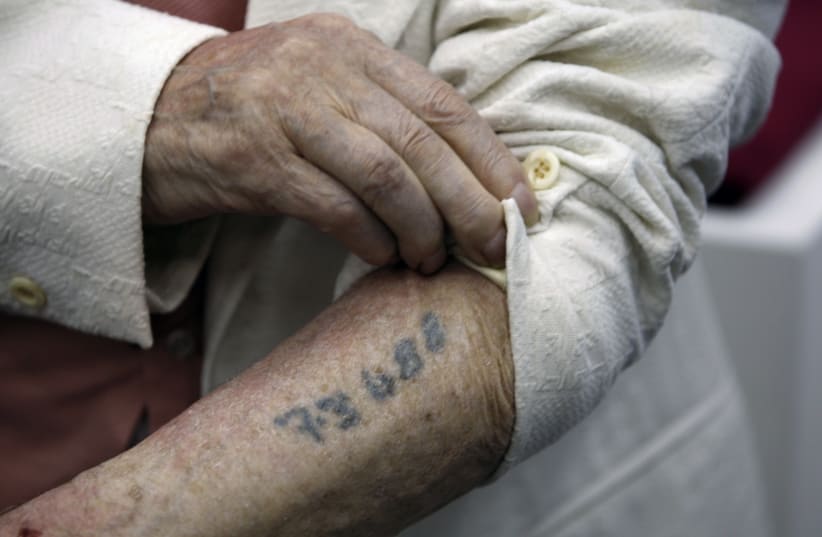The tools used to tattoo prisoners at the Auschwitz concentration camp during the Holocaust are up for sale by a Jerusalem auction house and will be sold to the highest bidder.
Tzolman’s Auctions, a relatively new auction house focused primarily on selling Judaica, old Jewish texts and historical documents, is selling a set of original needle seals used to tattoo Jewish prisoners in Auschwitz.
Many people have called on the auction house to cancel the auction and donate the artifacts to Yad Vashem, the Holocaust Martyrs’ and Heroes’ Remembrance Authority.
“The appropriate place for these historical artifacts from the period of the Holocaust is in Yad Vashem, the World Holocaust Remembrance Center, where they can be thoroughly researched, expertly preserved and ultimately utilized as historical testimony for the purposes of research, education and commemoration,” Yad Vashem chairman Dani Dayan said. “The trade of these items is morally unacceptable and only encourages the proliferation of counterfeits. Yad Vashem opposes the sale.”
However, Meir Tzolman, the auction house’s owner, said there was no reason to cancel the sale.
“I feel that by doing this sale, I have a great merit to help increase awareness of the suffering of Holocaust survivors,” he said. “In recent days, I have received a lot of phone calls from people who want to bid on the set to donate it to a museum. I hope this will ultimately be a win-win situation, where the owner gets a good price for it and that it will find a home in a museum where it can give proper respect to its history.”
Tzolman said he had received the set from a private individual in the US who got it from the concentration camp.
The set includes the marketing materials and instruction manual for the seals, produced by the German company Aesculap.
“Remember what Amalek did to you, do not forget!” the text on the auction page begins, recalling a biblical passage requiring Jews to maintain eternal vigilance against their enemies.
“The collection of seals before us symbolizes more than any other Holocaust item the most horrific tragedy faced by our people who have known many horrors,” the text said. “There is hardly a person living on earth who has not been exposed to the shocking numbers tattooed in bluish ink on the arm of Auschwitz survivors, the numbers that tell the story of the systematic and terrifying extermination, and the way that they were treated as less than animals.”
The set is part of a lot of hundreds of Judaica products set to be sold by auction house on November 9. The price was set at $1,400 as of Tuesday morning, with the auction house saying it expected it to sell for $30,000-$40,000.
According to the auction house, the set for sale is the third such collection in the world known to have survived World War II. The other two are located in the Military Museum in St. Petersburg, Russia, and in the museum operating at the memorial site where the Auschwitz camp was located. This collection, with eight different seals, is twice as large as either of the other two sets.
WHEN THE set of four tattoo stamps was received by the Auschwitz Museum from an anonymous donor in 2014, the museum’s director, Piotr Tsivinski, told the British Telegraph newspaper: “We never believed we would get the original tools used to tattoo prisoners after so long. These stamps will become a valuable display item in future exhibitions. The appearance of these tattoos is becoming rarer by the day, with the deaths of former prisoners, but the stamps will continue to express the dramatic history here, even after so many years.”
Author Yechiel De-Nur described the terrible humiliation experienced by tattooed owners: “Thirty years since my flesh was burned I made sure it was not seen by an outsider. For 30 years there has been no short-sleeved shirt in my closet, and during the long summer months in the sun-beaten country, I always had a towel hanging on my left arm... however, it always seems to me that everyone’s eyes are focused on my left arm, for I have never adapted to this number which is burned not only in my flesh but also in my soul. To this day, I can never remember what the number is, and I would need to look at my arm to tell it over.”
The Nazis started tattooing prisoners at Auschwitz in the fall of 1941, using a metal mold about an inch-and-a-half long in which needles are arranged in the shape of numbers. The Nazis used the metal seals by inserting them into a wooden mold, by means of which the needles were pressed into the prisoners’ skin, and immediately after their removal, ink was smeared into the bleeding holes.
Initially, only numbers were tattooed, but as more prisoners were brought in, the Nazis began using letters as well on May 13, 1944. Male Jewish prisoners were placed in Series A and then Series B after those numbers were all used up.
With the liberation of the camp on January 27, 1945, and the defeat of Germany, the letter C was not used. However, a seal with a C appears in the auction house collection, “apparently in preparation for the next stage of the extermination of world Jewry, which was avoided by the grace of heaven.”
Aesculap, which produced the seals, was a huge company founded in 1867 to make fine surgical instruments. During both world wars, it also manufactured weapons components for the German war machine.
Today, the company has close to 4,000 employees and annual sales of nearly €2 billion ($2.32b.). In the instruction manual accompanying the seals, the company describes the set as being designated for cattle markings, although the size of the numbers used is much smaller than those used for cattle and clearly designed for use on humans, the auction house said.
